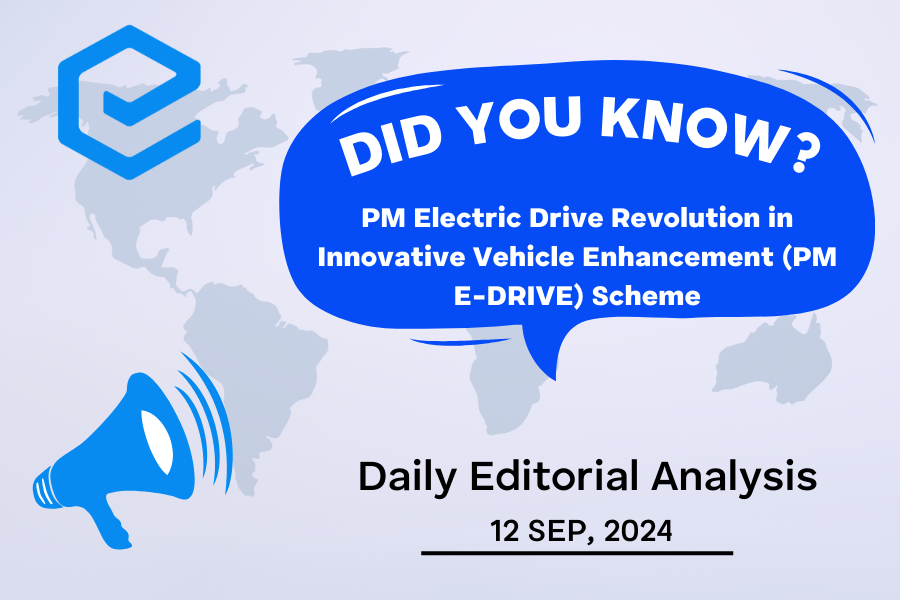The PM-led Union Cabinet approved the ‘PM Electric Drive Revolution in Innovative Vehicle Enhancement (PM E-DRIVE) Scheme’ for the promotion of electric mobility in the country. The scheme, proposed by the Ministry of Heavy Industries (MHI), will replace the existing FAME program and has an outlay of Rs 10,900 crore over two years.

Tags:GS-3, India Achievements inTechnology- Mobilization of ResourcesGS Paper – 2 , Polity & Governance- Government Policies & Interventions

Contents
India’s EV Revolution:
- Need:
- At the COP26 to the UNFCCC (held in Glasgow, UK, in 2021), the Indian PM presented to the world Panchamrit of India’s climate action plan.
- The Panchamrit/ the 5 nectar elements included:
- Increasing non-fossil fuel capacity by 500 GW by 2030.
- 50% of its energy requirements will come from renewable energy by 2030.
- Reduction of total projected carbon emissions by 1 billion tonnes from now to 2030.
- Reduction of the carbon intensity of the economy by 45% by 2030, over 2005 levels.
- Achieving the target of net zero emissions by 2070.
- Apart from this, the Indian PM also highlighted ‘Lifestyle for Environment’ (LiFE) – a global mission asserting the need to follow a sustainable lifestyle.
- Electric vehicles (EVs) can help India achieve its Panchamrit and LiFE goals by reducing emissions, improving energy security, etc.
- Steps taken by India:
- National Electric Mobility Mission Plan (NEMPP): The MHI launched the NEMMP 2020 in 2013 for deploying 5 to 7 million EVs in the country by 2020, lowering vehicular emissions by 1.3 to 1.5% by 2020, etc.
- The Faster Adoption and Manufacturing of Electric Vehicles (FAME) India Scheme:
- Launched as part of the NEMPP, the FAME India scheme has been implemented since 1st April 2015.
- Under this, subsidies are being given to promote manufacturing of electric and hybrid vehicle technology and to ensure sustainable growth of the same.
- Subsidies are meant to bring a price parity between vehicles that have electric motors and fossil fuel-run engines, thereby nudging buyers to go for the cleaner option.
- The first phase – FAME I, ran for four years until 2019. Under the FAME II (which ended on 31st March 2024), companies can – Offer a discount of up to 40% on the cost of locally manufactured vehicles and Claim it as a subsidy from the government.
- Production Linked Incentive (PLI) Scheme for the Automotive Sector: To boost domestic manufacturing of advanced automotive technology (AAT) products and attract investments in the automotive manufacturing value chain.
- PLI Scheme for National Programme on Advanced Chemistry Cell (ACC) Battery Storage: To enhance capabilities for the manufacture of ACC in India.
- Achievements of India’s EV revolution:
- The value of the Indian EV market in 2023 was US$2bn, and the projection by 2025 is US$7.1bn, with the domestic market achieving 10 million annual sales by 2030.
- Two-wheelers are driving this development, and they will make up 40-50% of all EVs sold in India by 2030.
- Over the past two years, the number of public chargers skyrocketed from a modest 1,800 to an impressive 16,347.
- EV revolution in India faces several challenges: Such as poor charging infrastructure, high cost (more expensive than conventional vehicles), battery lifespan, talent gap, lack of standardization (of charging infra and techs) and regulatory challenges (like unclear guidelines).
About the PM E-DRIVE Scheme:
- Objectives:
- The scheme seeks to accelerate the adoption of electric vehicles in India by offering upfront incentives for their purchase and facilitating the creation of necessary charging infrastructure.
- Its goal is to reduce the environmental impact of transportation and improve air quality through the promotion of EVs, mass public transportation, and advanced EV technologies.
- Key highlights:
- Subsidies and demand incentives: The scheme allocates Rs 3,679 crore to incentivise the purchase of electric two-wheelers (e-2Ws), three-wheelers (e-3Ws), electric ambulances, trucks, and other emerging EV categories.
- E-Vouchers for EV buyers:
- Buyers of electric vehicles will be issued an e-voucher under the scheme to avail demand incentives.
- The e-voucher will be Aadhaar-authenticated and sent to the buyer’s registered mobile number after the purchase.
- E-Ambulance deployment: A budget of Rs 500 crore has been allocated to deploy electric ambulances. This new initiative aims to provide comfortable and environmentally friendly patient transport.
- E-Buses for public transport: Rs 4,391 crore has been earmarked for the procurement of 14,028 e-buses by State Transport Undertakings (STUs) and public transport agencies.
- Incentives for E-Trucks: Rs 500 crore has been allocated to promote the deployment of e-trucks, a major contributor to air pollution.
- Charging infrastructure: To address range anxiety and support the growth of electric vehicles, Rs 2,000 crore will be used to install public charging stations (EVPCS) in cities with high EV penetration and along selected highways.
- Modernisation of testing facilities: An additional Rs 780 crore has been approved to modernize MHI’s test agencies, ensuring they are equipped to handle new and emerging green mobility technologies.
UPSC Civil Services Examination, Previous Year Questions (PYQs)
Mains
Q:1 How is efficient and affordable urban mass transport key to the rapid economic development in India? (2019)
Source: IE
To get free counseling/support on UPSC preparation from expert mentors please call 9773890604
- Join our Main Telegram Channel and access PYQs, Current Affairs and UPSC Guidance for free – Edukemy for IAS
- Learn Economy for free- Economy for UPSC
- Learn CSAT – CSAT for UPSC
- Mains Answer Writing Practice-Mains Answer Writing
- For UPSC Prelims Resources, Click here

